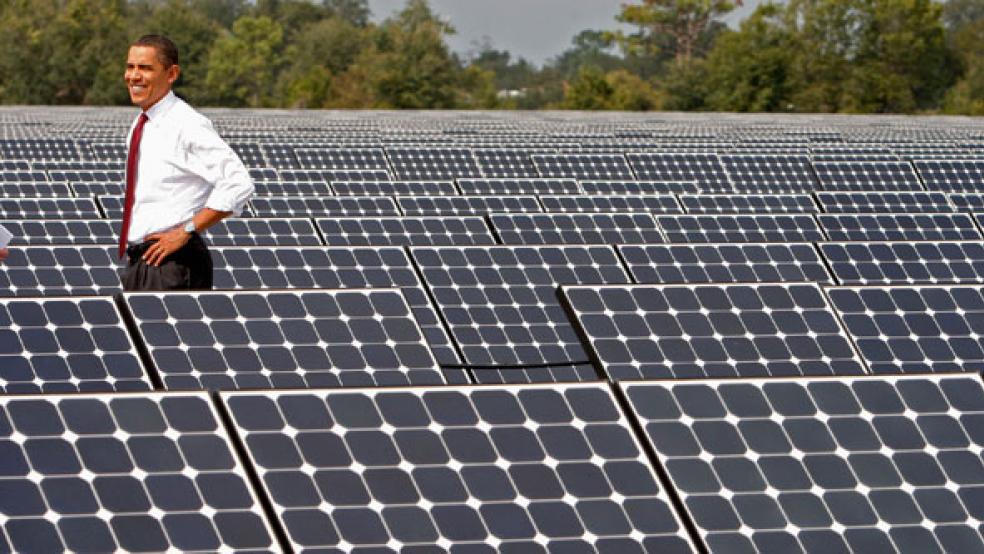When it comes to investing in clean energy, the federal government is all over the case. Eleven government departments and agencies operate a total of 94 programs to encourage clean energy projects and research in private sector buildings, a recent Government Accountability Office report revealed.
Talk about government overlap: The Department of Energy runs six separate programs to research ways to make commercial and residential programs more energy-efficient, while the Defense Department operates its own program called the Environmental Security Technology Certification Program to research and develop military-related environmentally-friendly technologies. In all, 83 of these programs target energy conservation in some way, 60 focus on indoor air quality, and 51 encourage water conservation.
Clean energy is a top priority of the Obama administration, which late last year launched an initiative offering businesses $2 billion to enhance their energy efficiency, while spearheading green building projects as part of the 2009 American Recovery and Reinvestment Act.
And while the president has stressed the importance of government reorganization and downsizing where possible, the administration has largely left dozens of “green” programs in place from previous administrations. The result is a "lasagna" of similar programs layered one on top of the other.
Obama’s fiscal 2013 budget calls for $6.7 billion in funding for clean energy programs across the federal government, a $760 million increase over 2012 spending levels.
“We’re not going to be able to drill our way out of high gas prices,” Obama said during an energy policy speech Wednesday in North Carolina. “ If we are going to control our energy future…we need to invest in the technology that will help us use less oil in our cars and our trucks, in our buildings, in our factories . . . As we start using less, that lowers the demand, prices come down. “
But this array of often overlapping energy-efficient building programs is inefficient and potentially waste itself, the GAO report found. [“How can you deliver services and achieve the overall goal of saving energy when every cook in the federal government is trying to get their hands in the energy-efficiency pot?”]
Federal agencies have increasingly raised their hands to lead energy-efficient building programs partly in an effort to boost agency resources, said Steve Ellis, Vice President for Taxpayers for Common Sense, a taxpayer watchdog group.
“If you suggest a program that’s part of a hot issue for the President, like energy-efficiency, you’re likely as an agency to get more favor and funding in the budget,” Ellis said. But that practice results in enormous overhead costs for separate program staffs, and paves the way for the type of overlap that undermines the whole effort, Ellis said. “How can you deliver services and achieve the overall goal of saving energy when every cook in the federal government is trying to get their hands in the energy-efficiency pot?” Ellis said.
Moreover, Republican lawmakers and presidential candidates have criticized the Obama administration’s clean energy programs as politically motivated cash infusions to companies like the now-bankrupt solar-panel firm Solyndra, at a time when the federal government can hardly afford it. The Energy Department provided Solyndra with a $535 million federal loan guarantee to help the company create jobs before it filed for bankruptcy last fall.
The Taxpayer Tab -- a Government Mystery
It’s unclear how much taxpayers spend on the 94 green building initiatives in the form of grants, loans, technical assistance, and tax incentives. That’s because many are combined with larger programs, and are not priced out individually by federal agencies. Equally unclear is the cost benefit of these programs, because two-thirds are not measured for their performance, GAO reported.
“Government-wide collaboration to identify performance information could, among other things, help inform efforts to evaluate the potential for inefficient or costly duplication and overlap across the more than 90 federal initiatives—implemented by 11 agencies—to foster green building,” the report stated.
Departments and agencies with their own green programs range from the Departments of Energy, Agriculture and Health and Human Services to the Pentagon, Housing and Urban Development and Transportation. White House officials and clean energy advocates say these cornucopia of programs reflects the complicated job of spurring different parts of the private sector to be more eco-friendly —and not duplicative efforts.
[These agencies operate separate programs to accomplish very similar tasks, such as the six programs in the Energy Department to research the energy efficiency of commercial and residential programs.]
“Each of these programs is really targeted to different audiences, different ownership types and different elements of green,” a senior Housing and Urban Development official told The Fiscal Times this week. The players include building designers, real estate agents, lenders, and the businesses occupants.
A review of some of the programs shows that departments and agencies have specialized interests. The Energy Department’s central role is to research how to make commercial buildings and new forms of technology more energy-efficient through programs like the Building Technologies Program. The Environmental Protection Agency plays a heavy educational role, with activities such as the Indoor Environments and Energy Star programs that guide businesses and consumers on how to cost-effectively improve indoor air quality and track energy consumption and performance. Then, to really drive businesses to act, the Treasury Department offers businesses tax deductions and credits for buying equipment that cuts energy costs for lighting, heating, cooling, and hot water systems.
But in some cases, these agencies operate separate programs to accomplish very similar tasks, such as the six separate programs in the Energy Department to research means for enhancing the energy efficiency of commercial and residential programs. Some energy experts say the GAO’s findings raise a larger question: should the federal government even be in the business of encouraging private companies and commercial developers to use less energy?
Conservative-leaning analysts argue that federal grants and tax incentives are unnecessary since market forces are enough to encourage companies to invest in energy-saving technology. If a company views green building investments as a way to shore up profits, the company will make that change on its own," said Jerry Taylor, a senior fellow at the libertarian Cato Institute. “There’s zero reason for the taxpayer to be subsidizing companies to make investments that are in their manifest best interest to make. Why don’t their shareholders pay for those investments?” Taylor said.
Environmentalists counter that while that may be true for a business that owns the building or property they work in, the subsidies help to correct a market failure for building owners who lease to tenants, and often choose not to adopt energy-savers since they won’t reap the savings.
“You get a situation where the owner has to shoulder the costs for installing high-tech energy investments, the tenant reaps the savings in their energy bill, and often the owner gets nothing back unless they can get a higher rent for it, which in this market is hard,” said Bracken Hendricks, a senior fellow at the Center for American Progress, a progressive think tank. “Many building owners start thinking along the lines of ‘I’m not going to invest in something that’s going to help you. So in my mind, it’s totally legitimate to have those tax code business incentives to help a commercial owner create productive investments and upgrade their equipment.”





